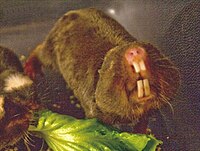Damaraland mole-rat
| Damaraland mole-rat | |
|---|---|
 |
|
| Scientific classification | |
| Kingdom: | Animalia |
| Phylum: | Chordata |
| Class: | Mammalia |
| Order: | Rodentia |
| Family: | Bathyergidae |
| Genus: | Fukomys |
| Species: | F. damarensis |
| Binomial name | |
|
Fukomys damarensis (Ogilby, 1838) |
|
| Synonyms | |
|
Cryptomys damarensis |
|
Cryptomys damarensis
The Damaraland mole-rat, Damara mole rat, or Damaraland blesmol (Fukomys damarensis) is a burrowing rodent found in southern Africa. Along with the smaller, less hairy, naked mole rat, it is one of only two known eusocial mammals.
Like other blesmols, the Damaraland mole-rat has a cylindrical body with short, stout limbs, large feet, and a conical head. It is also similar in size to most other African mole-rats, having a head-body length of 14 to 20 cm (5.5 to 7.9 in), with a short, 2 to 3 cm (0.79 to 1.18 in), tail, and weighing between 100 and 280 grams (3.5 and 9.9 oz). There are no external ears, and the blue-coloured eyes are tiny with thick eyelids. The incisor teeth are large and prominent, with flaps of skin behind them to prevent soil from falling into the throat while the animal is using them to dig.
The fur is short and thick, and varies from fawn to almost black, with shades of brown being most common. There is always a white patch on the top of the head, although its exact shape varies, and there may also be additional blotches of white fur elsewhere on the body. Longer sensory hairs project above the fur over much of the body, with the facial whiskers being particularly long. Females have six teats.
Although named specifically for Damaraland, the mole-rats are found across much of southern Africa, including Botswana, Namibia, South Africa, Zambia, and Zimbabwe. They inhabit warm, semi-arid environments dominated by savannah scrubland or sandy grasslands. They are most commonly associated with red Kalahari psamments, and are found only where there is a sufficient supply of plants with subterranean storage organs.
Damaraland mole-rats are herbivorous, feeding solely on tubers, corms, and bulbs. Favoured foods include such plants as Acanthosicyos, Star-of-Bethlehem, Ledebouria, and Talinum. Their natural predators include mole snakes, and occasionally other local snakes, such as cobras. They do not drink, obtaining all their water from their food, which is also an important source of minerals. Unlike most other mammals, they can effectively metabolise these minerals without access to vitamin D, which they lack because they are normally never exposed to sunlight. The basal metabolic rate of Damaraland mole rats is also unusually low for mammals of their size, at just 0.66 cm3 O2 / g · h.
...
Wikipedia

